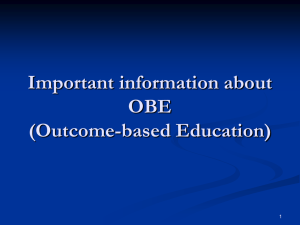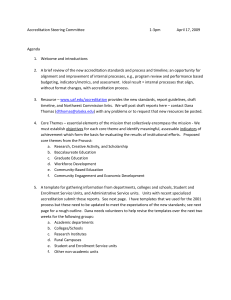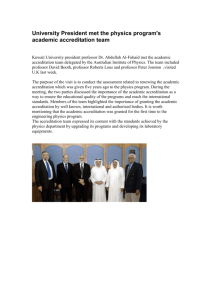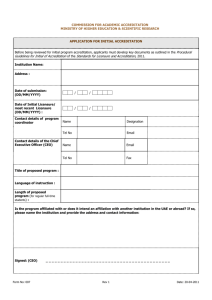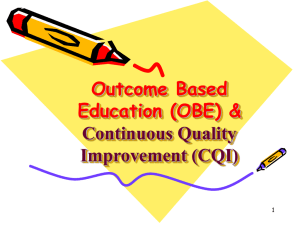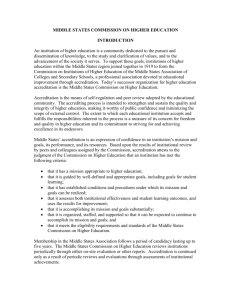EAC MANUAL 2012 - Pakistan Engineering Council
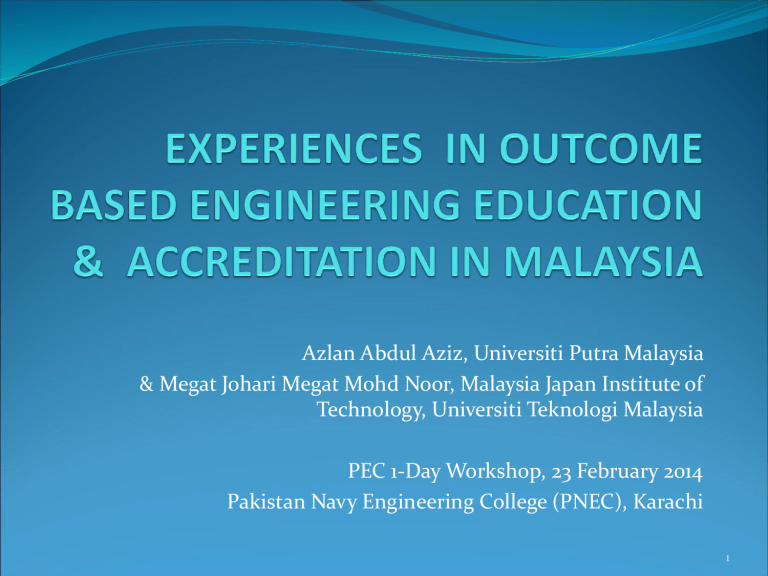
Azlan Abdul Aziz, Universiti Putra Malaysia
& Megat Johari Megat Mohd Noor, Malaysia Japan Institute of
Technology, Universiti Teknologi Malaysia
PEC 1-Day Workshop, 23 February 2014
Pakistan Navy Engineering College (PNEC), Karachi
1
International Agreements /
Networks
PRACTICE EDUCATION
WASHINGTON
ACCORD
SYDNEY
ACCORD
DUBLIN
ACCORD
FEANI / EUR-ACE / ENAEE
(EUROPE)
NABEEA
(ASIA)
2
UPADI
(CENTRAL & SOUTH AMERICA)
ENGINEERS MOBILITY FORUM
APEC ENGINEER
ENGINEERING TECHNOLOGISTS
MOBILITY FORUM
INTERNATIONAL
ENGINEERING ALLIANCE
(IEA) / formerly INTERNATIONAL
ENGINEERING MEETING
(IEM)
INTRODUCTORY REMARKS
In Malaysia,
Purpose of accreditation – graduates of accredited degree are able to register with the Board of Engineers
Malaysia (BEM)
Engineering Accreditation Council (EAC), a body delegated by BEM to conduct accreditation of engineering programmes. EAC has representatives from BEM, IEM, Malaysian Quality Authority (MQA) and Public Services Dept. (PSD)
3
INTRODUCTORY REMARKS
Focus of EAC
Ensuring the expected engineering education level is maintained (breadth and depth)
Outcome-based engineering education (OBE) programme is practised
Continual Quality improvement (CQI) on Programmes applied
Quality Management System practised
4
INTRODUCTORY REMARKS
Accreditation History
WA license due for renewal 2015. Expected visit by WA
Reviewers as observers on accreditation exercise to
Institutions of Higher Learning in late 2014/early 2015
Expectation
1999-2005: Sufficient if IHL have OBE plans and infancy implementation
2006-2012: Implement OBE in a systems approach. Full WA signatory 2009
2013-2019: Efficacy/ Efficiency/ Effectiveness of
OBE systems
2020 OBE at IHL is de rigueur
5
ACCREDITATION PROCEDURE
Schedule a visit after application from IHL. 6 months before final exams of first graduating cohort.
Accreditation Cycle: 5 years
Provide Self Assessment Report (SAR) in accordance to criteria and as specified in manual.
Accreditation Visit (2 days incl. nightly meetings), not limiting to:
Meeting with prog. admin., staff, students, alumni and employers; visit facilities and check documents.
6
ACCREDITATION PROCEDURE
VISIT DAY
Visit include
(1) Opening Meeting: led by EAC evaluators & followed by
IHL ‘short’ presentation
(2) Evaluation: Evidence-based through interviews, checking documents and records, and observation (‘triangulation’)
(3) Closing/Exit Meeting for clarification or correction of factual inaccuracies. No arguments nor solutions are requested.
7
ACCREDITATION PROCEDURE
Professionalism during Visit Day
Short and concise briefing from both evaluators and IHL (Note:
SAR is self-explanatory and comprehensive). IHL should concentrate on what is NEW and focus on NICHE of programmes
Organised
Punctual – keep to provided and prepared schedule
Courteous
Not argumentative
Well dressed
Not over friendly. Be formal
8
ACCREDITATION PROCEDURE
Professionalism during Visit Day (Ctd…)
Working lunch/teas in evaluation room among panel evaluators only
Do not provide tokens/gifts to evaluators
Provide name tags, signage, computer and printing facilities
Ensure right persons/ guides available at the appointed time
EAC Schedules
Accreditation Decision Meeting in April, August and December every year. Submission deadline of SAR and planned visit by
January 31 every year.
9
Accreditation Criteria and Qualifying
Requirements
Staff
Students
PEO
&
PO
Curriculum QMS
Facilities
10
11
Programme Objectives (PEO) and Programme Outcomes (PO)
PEOs are specific goals consistent with the vision & mission of IHL
Published statements of PEO
Clear linkages between PEO and PO
Involvement of constituents/ stakeholders
Expected to be achieved/analysed a few years after graduation (usually for about 5 years of employment)
POs are statements that describe what students are expected to know and be able to perform or attain by the time of graduation
12
Programme Outcomes
OLD (2007)
(i) ability to acquire and apply knowledge of science and engineering fundamentals;
(ii) acquire in‐depth technical competence in a specific engineering discipline;
(iii) ability to undertake problem identification, formulation and solution;
NEW based on IEA WA (2012)
(i) Engineering Knowledge - Apply knowledge of mathematics, science, engineering fundamentals and an engineering specialisation to the solution of complex engineering problems;
(ii) Problem Analysis - Identify, formulate, research literature and analyse complex engineering problems reaching substantiated conclusions using first principles of mathematics, natural sciences and engineering sciences;
13
Programme Outcomes
OLD (2007)
(v) understanding of the principles of design for sustainable development;
NEW (2012)
(iii) Design/Development of
Solutions - Design solutions for complex engineering problems and design systems, components or processes that meet specified needs with appropriate consideration for public health and safety, cultural, societal, and environmental considerations;
14
Programme Outcomes
OLD (2007)
(iv) ability to utilise systems approach to design and evaluate operational performance;
NEW (2012)
(iv) Investigation - Conduct investigation into complex problems using research based knowledge and research methods including design of experiments, analysis and interpretation of data, and synthesis of information to provide valid conclusions;
15
Programme Outcomes
OLD (2007) NEW (2012)
(v) Modern Tool Usage - Create, select and apply appropriate techniques, resources, and modern engineering and IT tools, including prediction and modelling, to complex engineering activities, with an understanding of the limitations;
16
Programme Outcomes
OLD (2007)
(vi) understanding of professional and ethical responsibilities and commitment to them;
NEW (2012)
(vi)The Engineer and Society - Apply reasoning informed by contextual knowledge to assess societal, health, safety, legal and cultural issues and the consequent responsibilities relevant to professional engineering practice;
(ix) understanding of the social, cultural, global and environmental responsibilities of a professional engineer; and
(vii) Environment and Sustainability -
Understand the impact of professional engineering solutions in societal and environmental contexts and demonstrate knowledge of and need for sustainable development;
17
Programme Outcomes
OLD (2007)
(vi) understanding of professional and ethical responsibilities and commitment to them;
NEW (2012)
(viii) Ethics - Apply ethical principles and commit to professional ethics and responsibilities and norms of engineering practice;
(vii) ability to communicate effectively, not only with engineers but also with the community at large;
(ix)Communication - Communicate effectively on complex engineering activities with the engineering community and with society at large, such as being able to comprehend and write effective reports and design documentation, make effective presentations, and give and receive clear instructions;
18
Programme Outcomes
OLD (2007)
(viii) ability to function effectively as an individual and in a group with the capacity to be a leader or manager ;
NEW (2012)
(x)Individual and Team Work –
Function effectively as an individual, and as a member or leader in diverse teams and in multi-disciplinary settings;
(x) recognising the need to undertake life‐long learning, and possessing/acquiring the capacity to do so.
(xi) Life-long Learning - Recognise the need for, and have the preparation and ability to engage in independent and lifelong learning in the broadest context of technological change.
19
Programme Outcomes
OLD (2007) NEW (2012)
(xii)Project Management and Finance -
Demonstrate knowledge and understanding of engineering and management principles and apply these to one’s own work, as a member and leader in a team, to manage projects and in multidisciplinary environments;
20
Depth of Knowledge Required
Complex
Problems
(Engineer)
Broadly Defined
Problems
(Technologist)
Well defined
Problems
(Technician)
Requires in-depth knowledge that allows a fundamentals-based first principles analytical approach
Requires knowledge of principles and applied procedures or methodologies
Can be solved using limited theoretical knowledge, but normally requires extensive practical knowledge
21
Definition of Complex Problem
Solving (IEA WA)
The range of complex problem solving as required by the Programme
Outcomes in Section 4.0 is defined as follows:
1.
Attributes
Preamble
Complex Problems
Engineering problems which cannot be resolved without in-depth engineering knowledge, much of which is at, or informed by, the forefront of the professional discipline, and have some or all of the following characteristics listed below:
2.
Range of conflicting requirements
Involve wide-ranging or conflicting technical, engineering and other issues.
3. Depth of analysis required Have no obvious solution and require abstract thinking, originality in analysis to formulate suitable models.
22
Definition of Complex Problem
Attributes
Solving
Complex Problems
4.
Depth of knowledge required
5.
Familiarity of issues
Requires research-based knowledge much of which is at, or informed by, the forefront of the professional discipline and which allows a fundamentals-based, first principles analytical approach.
Involve infrequently encountered issues
6.
Extent of applicable codes Are outside problems encompassed by standards and codes of practice for professional engineering.
7.
Extent of stakeholder involvement and level of conflicting requirements
Involve diverse groups of stakeholders with widely varying needs.
23
Definition of Complex Problem
Solving
Attributes
8.
Consequences
9.
Interdependence
Complex Problems
Have significant consequences in a range of contexts.
Are high level problems including many component parts or sub-problems.
24
Definition of Complex Engineering
Activities
The range of complex engineering activities is defined as follows:
Attributes
1.
Preamble
2.
Range of resources
3. Level of interaction
Complex Activities
Complex activities means (engineering) activities or projects that have some or all of the following characteristics listed below:
Involve the use of diverse resources (and for this purpose, resources include people, money, equipment, materials, information and technologies).
Require resolution of significant problems arising from interactions between wide ranging or conflicting technical, engineering or other issues.
25
Definition of Complex Engineering
Activities
Attributes
4.
Innovation
5.
Consequences to society and the environment
6.
Familiarity
Complex Activities
Involve creative use of engineering principles and research-based knowledge in novel ways
Have significant consequences in a range of contexts, characterised by difficulty of prediction and mitigation.
Can extend beyond previous experiences by applying principles-based approaches.
26
Knowledge Profile (Curriculum)
The curriculum shall encompass the knowledge profile as summarised in the table below:
Knowledge Profile
A systematic, theory-based understanding of the natural sciences applicable to the discipline (e.g. calculus-based physics)
Conceptually-based mathematics, numerical analysis, statistics and formal aspects of computer and information science to support analysis and modelling applicable to the discipline
A systematic, theory-based formulation of engineering fundamentals required in the engineering discipline
Engineering specialist knowledge that provides theoretical frameworks and bodies of knowledge for the accepted practice areas in the engineering discipline; much is at the forefront of the discipline
Knowledge that supports engineering design in a practice area
27
Knowledge Profile (Curriculum)
Knowledge Profile
Knowledge of engineering practice (technology) in the practice areas in the engineering discipline
Comprehension of the role of engineering in society and identified issues in engineering practice in the discipline: ethics and the professional responsibility of an engineer to public safety; the impacts of engineering activity: economic, social, cultural, environmental and sustainability
Engagement with selected knowledge in the research literature of the discipline
28
Outcome Based Education
OBE is a process that involves assessment and evaluation practices in education to reflect the attainment of expected learning outcomes and showing mastery in the programme area
OBE in a Nutshell
What do you want the students to have or able to do?
How can you best help students achieve it?
How will you know what they have achieved?
How do you close the loop
29
Strategy of OBE
Top down curricula design
Appropriate Teaching & Learning
Methods
Appropriate Assessment &
Evaluation Methods
30
Characteristics of OBE curricula
It has programme objectives, programme outcomes, course learning outcomes and performance indicators. It is centered around the needs of the students and the stakeholders.
It is objective and outcome driven, where stated objective and outcomes can be assessed and
evaluated.
Suitable tools and methods are used to measure and evaluate attainment of the outcomes
Results from evaluation are used for CQI
31
Institutional
Mission Statement
Stakeholders Interest
Programme Objectives
Programme Outcomes
(Knowledge, skills, attitudes of graduates)
Outcome-Related Course Learning Objectives
(Ability to: explain, calculate, derive, design)
Assessment of Attainment Level
Continual Improvement
32
Bloom’s Taxonomy
Knowledge (list)
Comprehension (explain)
Application (calculate, solve, determine)
Analysis (classify, predict, model,derived)
Synthesis (design, improve)
Evaluation (judge, select, critique)
33
lower order Intermediate Higher order
34
lower order Intermediate Higher order
35
36
Learning Style Model
Perception
Sensing Intuitive
Input Modality Visual Verbal
Processing Active Reflective
Understanding Sequential Global
37
Visual (Vs) Learners
“Show me”
- pictures
- diagrams
- sketches
- schematics
- flow charts
- plots
Verbal (Vb) Learners
“Explain it to me”
- spoken words
- written words, symbols (seen, but translated by brain into their Oral equivalents)
38
Active (A) Learners
Tend to process actively (doing something physical with presented material, then reflecting on it)
Think out loud
Reflective (R) Learners
Tend to process reflectively
(thinking about presented material, then doing something with it)
Work introspectively
“let’s try it out and see how it goes”
Tend to jump in prematurely
Like group work
“Let’s think it through and then try it”
Tend to delay starting
Like solo or pair work
39
Sequential (Sq) Learners Global (G) Learners
sequential steps
understanding of information
Built understanding in logical
Function with partial
Make steady progress
Explain easily
Absorb information randomly, then synthesize the big picture
Need the big pictures
(interrelations, connections to other subjects and personal experience) in order to function with information
Large leaps in understanding with little progress between them
Can’t explain easily
Good at analytical thinking (the trees)
Synthesis, holistic thinking (the forest)
40
41
Student-Centered Learning
42
ASSESSMENT:
Processes that identify, collect, use and prepare data for evaluation of achievement of programme outcomes or educational objectives.
EVALUATION:
Processes for interpretation of data and evidence from assessment practices that determine the program outcomes are achieved or result in actions to improve programme.
43
Course Coverage & Assessment
When assessing, an instructor must consciously assess and evaluate the applicable elements (Knowledge, Skills, Attitude). An activity may be used to examine all the three elements
Model A Model B
Competencies Competencies
Knowledge
Knowledge
Attitude
Skills
Attitude
Skills
44
Course Outcomes (CO) Contribution to
Programme Outcomes (PO)
Life Long Learning
Teach students about learning styles and help them identify the strength and weakness of their styles and give them strategies to improve
Use active learning methods to accustom them to relying on themselves
Give assignments that requires library and www searches
Anything done to fulfil criteria on: (a) understanding ethical and professional responsibility and (b) understanding societal and global context of engineering solutions, will automatically satisfy this
45 criteria
Assessment/Evaluation tools
Exit surveys, Exit interviews (P)
Alumni surveys and interviews (P)
Employer surveys and interviews (P)
Job offers, starting salaries (relative to national benchmark) (P)
Admission to graduate schools (P)
Performance in group and internship assignments and in PBL situation (P,C)
Assignments, report and tests in capstone design course (P,C)
Standardized tests (P,C)
P: Program C: Course
46
Assessment tools
(cont)
Student surveys, individual and focus group interviews (P,C)
Peer-evaluations, self evaluations (P,C)
Student portfolios (P,C)
Behavioral observation (P,C)
Written tests linked to learning objectives (C)
Written project reports (C)
Oral presentation, live or videotape (C)
Research proposals, student-formulated problems (C)
Classrooms assessment Techniques (C)
47
CONCLUDING REMARKS
Since the introduction of OBE & OBA, many initiatives have been undertaken by M’sian IHL and other institutions:
Training by EAC/ MySET/ IEM on OBE
Training by Higher Education Leadership Academy,
AKEPT on active learning delivery methods:
Problem Based Learning (PBL), Project Oriented
PBL, Case Study Method, etc
Software development to ‘close the loop’
48
49



